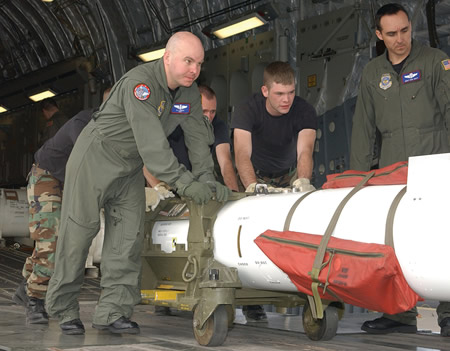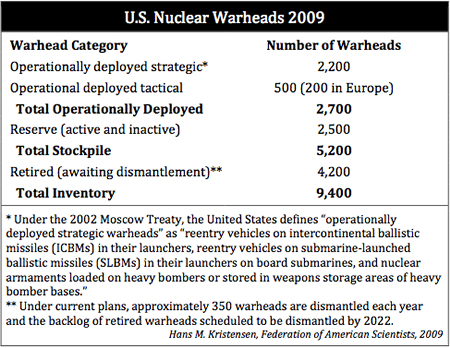United States Reaches Moscow Treaty Warhead Limit Early
 |
| B83 thermonuclear bombs are offloaded from a C-17 aircraft for storage in preparation for meeting the limit of the Moscow Treaty three and a half years early. |
.
By Hans M. Kristensen
The United States has reduced its deployed strategic warheads to the maximum number allowed under 2002 Moscow Treaty, three and a half years early.
As of today, a total of 2,200 strategic warheads are deployed on ballistic missiles and at long-range bomber bases. The reduction was initially planned to be met in 2012, then 2010, but was achieved a few days ago.
The information is described in the forthcoming “Nuclear Notebook: U.S. Nuclear Forces, 2009,” which I co-author with Robert Norris from Natural Resources Defense Council. The article will be published in the Bulletin of the Atomic Scientists later this month.
Warhead Number Confusion
We obtained the information from the U.S. government. While the number of operationally deployed strategic warheads is not classified the total number of weapons in the U.S. inventory is a closely held secret. The government also keeps secret how many warheads are held in reserve as well as the number of warheads dismantled each year.
As a result, there is considerable confusion in the public about the size and categories of U.S. nuclear weapons. One recent Associated Press report, for example, said the “American stockpile is believed to be about 2,300,” a number that is now being repeated by news media across the globe.
The stockpile number is not correct. Norris and I estimate that the U.S. “stockpile” currently includes approximately 5,200 warheads, of which only about half are deployed. This includes about 2,200 strategic and 500 tactical warheads (including 200 in Europe). Moreover, an additional roughly 4,200 intact warheads are no longer in the DOD Stockpile but awaiting dismantlement. All included, the United States is estimated to possess approximately 9,400 warheads in all categories (see table).
 |
.T
The “operationally deployed strategic warheads” is a special counting rule the United States uses under the Moscow Treaty. It does not count hundreds of warheads in storage at the Navy’s two missile submarine bases and the Air Forces’ three ballistic missile bases. Russia, which does not use this counting rule and does not release its warhead count, is estimated to have approximately 2,700 operational strategic warheads.
Reductions But What Kind?
The “real” numbers are important at a time when the United States and Russia are discussing if and how to extend the 1991 START agreement, which expires later this year, and whether to reduce further the number of nuclear warheads.
The news media has recently reported that the Obama administration might seek to cut the “stockpile” by 80 percent, and quoted an anonymous official saying “nobody would be surprised if the number reduced to the 1,000 mark for the post-Start treaty.”
It matters a great deal whether the cut will be of the total stockpile or just the “operationally deployed strategic warheads.” An 80 percent cut in the 5,200-warhead stockpile corresponds to approximately 1,000 warheads. A reduction of the START number limit (6,000 warheads) by 80 percent would leave about 1,200 warheads. Cutting the SORT limit (2,200 warheads) to 1,000 would be a reduction of about 54 percent.
If the total stockpile were reduced to 1,000 warheads, only a portion of them would presumably be deployed. Using the current ratio (52 percent) that would mean only 520 of the 1,000 warheads would be deployed with the balance in reserve. The entire ICBM force today carries about 520 warheads, but it is doubtful that a Triad could be justified with so few operational warheads. There are some hard choices ahead about which leg to cut.
Satellite imagery has long served as a tool for observing on-the-ground activity worldwide, and offers especially valuable insights into the operation, development, and physical features related to nuclear technology.
This report outlines a framework relying on “Cooperative Technical Means” for effective arms control verification based on remote sensing, avoiding on-site inspections but maintaining a level of transparency that allows for immediate detection of changes in nuclear posture or a significant build-up above agreed limits.
The grant comes from the Carnegie Corporation of New York (CCNY) to investigate, alongside The British American Security Information Council (BASIC), the associated impact on nuclear stability.
Satellite imagery of RAF Lakenheath reveals new construction of a security perimeter around ten protective aircraft shelters in the designated nuclear area, the latest measure in a series of upgrades as the base prepares for the ability to store U.S. nuclear weapons.